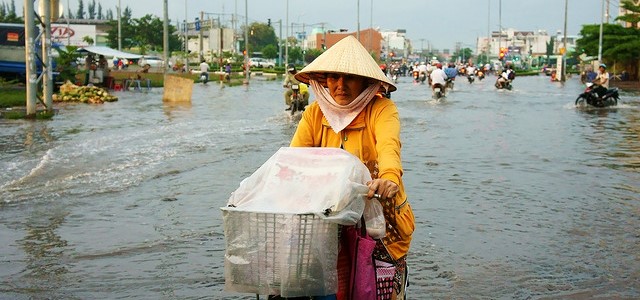Characteristics
Global warming and related climate changes will significantly influence the water environment in the coming decades. There is consensus that those changes will appear through the spatial distribution and timing of rainfall and might cause both more frequent and higher intensity floods and droughts. There is a firm consensus that it is predicted that a few degrees of change in temperature will directly impact the water environment to the extent that average river flows can increase in some areas by up to 40%, while in other areas, flows may decrease by up to 30%. Thus, the challenges are major and adaptation measures will have to be applied following a well-prepared adaptation policy.
Water resources managers have long been used to dealing with monthly and annual variations. But, we are moving from a stationary world, where the range of uncertainty was bounded, to a non-stationary one where the costs of inaction become higher. Thus, the situation where progressing climate changes are highly likely is new and requires a pro-active, rational and dynamic adaptation policy. The building blocks for such a policy are found in IWRM as this approach seeks to identify and achieve trade-offs between different management objectives, including environmental sustainability, economic efficiency and social equity – in the short and long terms. An adaptation policy has to consider the multi-sectoral aspects during preparation of the appropriate responses, so as to provide water security for the productive and non-productive sectors over time. The spatial-temporal dimensions of climate change will entice very different changes on say hydropower versus ecosystem use.
A policy also has to guide the selection of appropriate responses and interventions, set priorities of these interventions and outline how these interventions may be implemented. The policy will seek adaptive and “no-regret” interventions due to uncertainties involved. The adaptive responses are interventions that can be changed/adjusted marginally and in step with climate changes and can closely follow the ongoing development of the situation. “No-regret” interventions are those measures that turn out to be of benefit no matter how or if the predicted climate change impacts materialize. For example, increasing the irrigation capacity in rural areas may, on the one side, increase your ability to cope with extreme events such as floods and droughts but, on the other side, also holds great general benefits in terms of agricultural development.
A policy also has to prioritize and strike a balance between “hard interventions” and “soft interventions”. The soft interventions are those that deal with the development of institutions and human resources aiming to build capacity to address the climate change impacts. Flood warning systems and emergency preparedness are among the soft interventions. The “hard interventions” include infrastructural elements such as dams, flood walls and dikes. The financial situation of the nation will influence the choices and balances between “soft” and “hard” interventions. It is important that adaptation policy is not misinterpreted with conducting individual projects with the name of adaptation. If individual projects are not properly embedded within a broader adaptation policy, this might lead to white elephant projects.
Lessons learned
The experience in developing policies for climate change adaptation that build on better water resources management is still in its infancy. More successful policies are known to deal with:
- Strengthening of resource management institutions and water allocation laws accumulating information and capacity to predict, plan and cope with present and future climate changes and building up long-term resilience.
- Improvements in the integration of land and water management.
- Interventions and actions that take into account the multi-sectoral aspects of water use, conservation and protection as well as the adaptation potential and the “no-regret” character of the intervention.
- Frameworks for climate change adaptation at all levels from projects to communities and river basins to nations.
- The need for sound science and best practices as foundation for adaptation decisions; also improving and sharing knowledge and information and building comprehensive and sustainable data collection and monitoring systems.
- The prioritization and balancing between “soft” interventions and “hard” interventions.
- The balance between the social equity, the economic efficiency and the environmental sustainability.
- Preference for marginal changes rather than fundamental changes in development paths.
- Flood plain zoning, relocation and planned migration.

